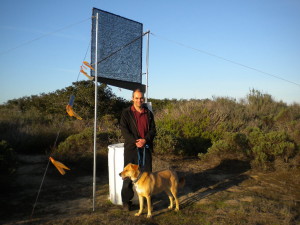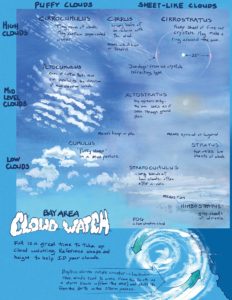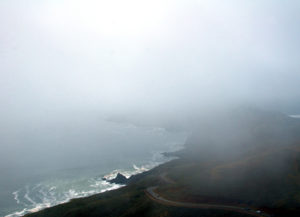A gauzy marine layer regularly envelops California’s Central Coast, wafting waves of misty air over the landscape. Even during a crippling drought, all that water, albeit airborne, is all around us. What if you could capture it?
It’s an idea that’s been tested out elsewhere. In some of the most remote and arid coastal places in the world, fog-collecting meshes the size of sails have been installed to augment the meager water resources of communities and farmers. Now, some are seeking to bring the technology to drought-prone California, where developing reliable, local sources of water supplies is gaining acceptance as a path to sustainability.
On the forefront of the research is Daniel Fernandez, a professor of science and environmental policy at California State University, Monterey Bay. He has developed and deployed dozens of “fogcatchers” throughout the region, testing their effectiveness with different materials and in different coastal areas. Fernandez has taught and researched sustainability issues for many years on topics ranging from clean energy to large-scale composting, as well as water conservation.
“I was excited about the idea of being able to collect water from fog. It’s so unique and novel and interesting,” he said. “My thinking was, maybe this could be a way to address some of the water concerns that we’re having in California.”

As Fernandez started thinking about harvesting water from fog, he came across an organization called FogQuest, a nonprofit based in British Columbia, Canada. It formed in 2000 and has contributed to fog collecting projects in Chile, Namibia, Nepal and Yemen, among other places.
Robert Schemenauer, executive director and co-founder of FogQuest and an expert in cloud physics and atmospheric sciences, pioneered the first modern fog-collection systems in 1994. The current standard for fog collection devices, including Fernandez’s fogcatcher, is based on his early designs. Schemenauer developed the meshes by adapting ones farmers used in the agricultural sector; he worked with two Chilean universities and a nonprofit sustainable forest group in Chile, the National Forest Corporation, in the 1980s. Together they wrote the first scientific papers on fog collectors in the early 1990s, based on their pilot project at El Tofo Mountain in northern Chile.
“Part of our early work in Chile was to determine which inexpensive and durable material would be efficient at collecting microscopic fog droplets,” he said.
When Fernandez first got started, FogQuest helped him out. He and a student ordered their first fog collectors from them, and they were shipped all the way from Chile. After they set up the fog collectors, Schemenauer visited them at Monterey Bay and made some helpful suggestions. Fernandez and his collaborator, Peter Weiss at the University of California, Santa Cruz, now make their own fog collectors following Schemenauer’s specifications. Dozens stand poised like sentinels across coastal cliffs and fields along the Central Coast, awaiting the marine layer to enshroud them.
Fog is most frequent during the height of the summer dry season in California, adding much needed moisture to coastal ecosystems. In such environments, wind can drive an upwelling of cold water on the ocean surface, creating a temperature gradient that cools the moist air above. Water vapor then condenses into droplets in the air, and this is where the fog collectors do their part. Each one is about one-square meter in surface area and includes a fine mesh net made of plastic fiber. The net intercepts the fog as it passes through and captures its suspended water droplets, which slowly dribble into a steel trough below, collecting the water for future use.
In a way, the mesh is an example of biomimicry: its fibers coalesce and channel the water similar to the way the surface and ridges of a leaf naturally collects dew along its stem. The fog collectors have also been compared to the dew collectors in the drought-afflicted world conceived in Frank Herbert’s 50-year-old novel, Dune.

Fog and wind come and go very rapidly, but on a good day, which often occurs near the ocean around the Big Sur area, a fog collector can extract up to nine gallons of potable water. More typical days yield one or two gallons. That’s a fraction of the 100 gallons of water per day consumed by the average American. You’d need a fog fence much larger than a house to fill the needs of an average household. So, although they are relatively cheap at $100-$200 a piece, they may never be as scalable as, say, rooftop solar. Still, the idea of using fog catchers to supplement water supplies is appealing.
There are other shortcomings — notably, pollution. Fog has been found to be a conveyor of toxic mercury from ocean upwelling, and could also be transporting chemical compounds from industrial sources. “Fog has a whole soup of different chemicals that are interacting in a variety of ways,” Fernandez said.
And then there’s the bigger question of what will happen to fog as the climate warms. There’s plenty of evidence that the California coastline is experiencing declines in fog levels — and that wouldn’t be a promising future for fog-collecting technology.
But perhaps fog catchers do hold a place in a smorgasbord of options that California is considering as it prepares for more episodes of drought. “California really needs an all-of-the-above approach to adapt to water scarcity,” said Ellen Hanak, the Public Policy Institute of California’s Water Policy Center director, at a forum in Monterey in August.
And in that sense, fog collecting — like rain barrels and groundwater banking — if used in the right place and with the right purpose, could be a step towards water sustainability.





